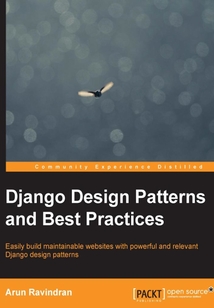舉報 

會員
Django Design Patterns and Best Practices
最新章節:
Index
IfyouwanttolearnhowbesttoutilizecommonlyfoundpatternsandlearnbestpracticesindevelopingapplicationswithDjango,thisisthebookforyou.Thisbook,likeDjangoitself,isaccessibletoamateurandprofessionaldevelopersalikeandassumeslittleinthewayofpriorexperience.AlthoughwrittenforPython3,themajorityofthecodeinthisbookworksinPython2orcanbeeasilytranslated.
目錄(104章)
倒序
- coverpage
- Django Design Patterns and Best Practices
- Credits
- About the Author
- About the Reviewers
- www.PacktPub.com
- Support files eBooks discount offers and more
- Preface
- What this book covers
- What you need for this book
- Who this book is for
- Conventions
- Reader feedback
- Customer support
- Chapter 1. Django and Patterns
- Why Django?
- The story of Django
- What is a Pattern?
- Patterns in this book
- Best practices
- Summary
- Chapter 2. Application Design
- How to gather requirements
- Are you a story teller?
- HTML mockups
- Designing the application
- Before starting the project
- SuperBook – your mission should you choose to accept it
- Summary
- Chapter 3. Models
- M is bigger than V and C
- The model hunt
- Structural patterns
- Retrieval patterns
- Migrations
- Summary
- Chapter 4. Views and URLs
- A view from the top
- Class-based generic views
- View mixins
- Decorators
- View patterns
- Designing URLs
- Summary
- Chapter 5. Templates
- Understanding Django's template language features
- Organizing templates
- Using Bootstrap
- Template patterns
- Summary
- Chapter 6. Admin Interface
- Using the admin interface
- Enhancing models for the admin
- Admin interface customizations
- Protecting the admin
- Summary
- Chapter 7. Forms
- How forms work
- Displaying forms
- Understanding CSRF
- Form processing with Class-based views
- Form patterns
- Summary
- Chapter 8. Dealing with Legacy Code
- Finding the Django version
- Where are the files? This is not PHP
- Starting with urls.py
- Jumping around the code
- Understanding the code base
- Incremental change or a full rewrite?
- Write tests before making any changes
- Legacy databases
- Summary
- Chapter 9. Testing and Debugging
- Why write tests?
- Test-driven development
- Writing a test case
- Mocking
- Pattern – test fixtures and factories
- Learning more about testing
- Debugging
- The print function
- Logging
- The Django Debug Toolbar
- The Python debugger pdb
- Other debuggers
- Debugging Django templates
- Summary
- Chapter 10. Security
- Cross-site scripting (XSS)
- A handy security checklist
- Summary
- Chapter 11. Production-ready
- Production environment
- Hosting
- Deployment tools
- Monitoring
- Performance
- Summary
- Appendix A. Python 2 versus Python 3
- But I still use Python 2.7!
- Python 3
- Further information
- Index 更新時間:2021-07-23 19:36:37
推薦閱讀
- VSTO開發入門教程
- Python機器學習實戰
- Java EE 7 Development with NetBeans 8
- PhoneGap Mobile Application Development Cookbook
- SQL Server 2016數據庫應用與開發
- R語言與網絡輿情處理
- 從Java到Web程序設計教程
- MySQL從入門到精通(軟件開發視頻大講堂)
- OpenCV with Python By Example
- PHP編程基礎與實踐教程
- 機器學習微積分一本通(Python版)
- Visual Basic程序設計(第三版)
- Python物理建模初學者指南(第2版)
- Joomla!Search Engine Optimization
- 軟技能2:軟件開發者職業生涯指南
- 趣味掌控板編程
- 面向物聯網的Android應用開發與實踐
- Swift從入門到精通 (移動開發叢書)
- 計算機視覺增強現實應用平臺開發
- R Data Visualization Cookbook
- Full Stack Development with JHipster
- 數控編程技能培訓:Cimatron中文版
- Spring 5.0 Cookbook
- 大規模Scrum:大規模敏捷組織的設計
- Web前端工程師修煉之道(原書第5版)
- Django項目開發實戰
- Java編程從零開始學(視頻教學版)
- Python數據分析從入門到精通
- 代碼質量
- 青少年軟件編程基礎與實戰(圖形化編程四級)

